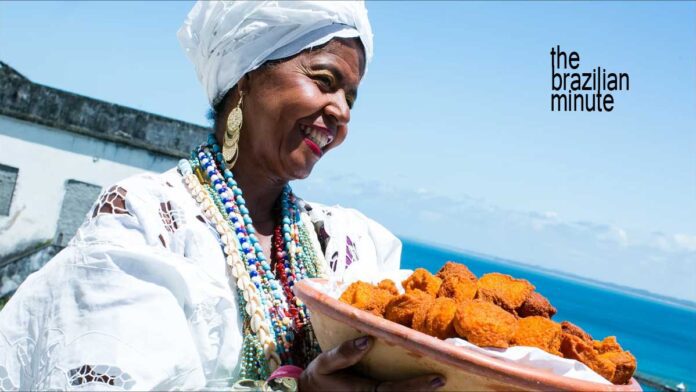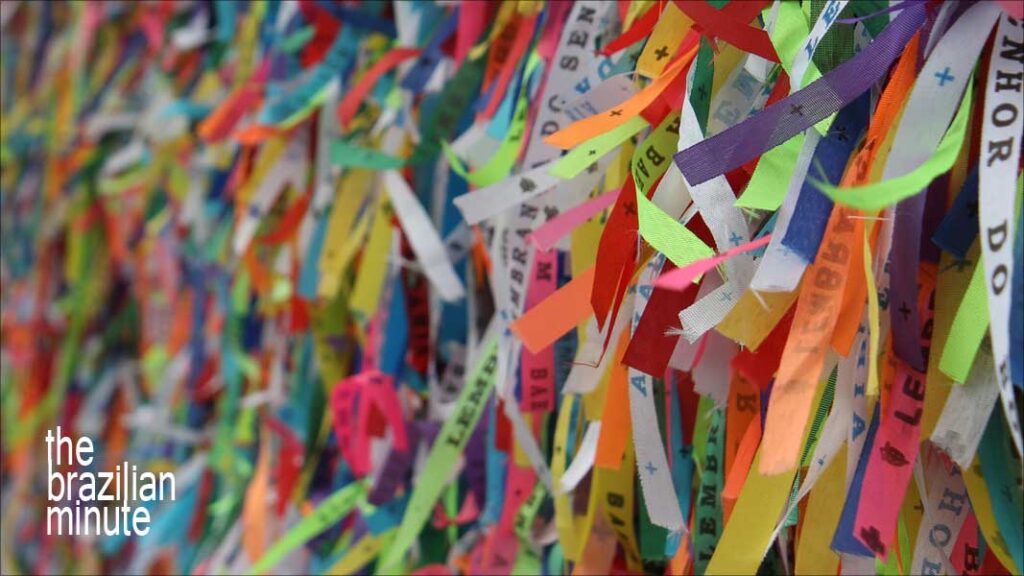
Brazil is home to the largest African diaspora population in the world.
African culture in Brazil is art, music, cuisine, religion, tradition, and history. At the heart of it all is Salvador, Bahia. Let’s explore!
This series was presented by the Consulate-General of Brazil in Chicago and the Brazilian Foreign Ministry’s Cultural Department.
In celebration of Brazil’s Bicentennial year, 1822 – 2022
This week’s Brazilian Minute: African Culture In Brazil
Catch up with other Brazilian Minute episodes you may have missed!
Script from Audio:
This week let’s explore African Culture In Brazil. Brazil is home to the largest African diaspora population in the world. Brazil has the world’s second-largest population of African descent after Nigeria.
African Culture In Brazil? It’s the sights and sounds of samba and capoeira. It is savory and delicious cuisine, like feijoada and vatapá.
It’s the prominent Afro-Brazilian religions of Candomblé, Macumba, and Umbanda. And it is Rio de Janeiro’s New Year’s Eve tradition of Iemanjá, sending gifts of flowers to the goddess of the sea.
For those wanting to learn more about Brazil’s deeply-rooted cultural connections to Mother Africa, we suggest a visit to Salvador, Bahia.
Bahia is regarded as the creative soul of Brazil, and the region which warmly embraces the rich cultural legacy of today’s Afro-Brazilians.
Read and listen to new weekly episodes of The Brazilian Minute. It’s brought to you by the Consulate General of Brazil, in Chicago and the Brazilian Foreign Ministry’s Cultural Department.

More on: African Culture In Brazil
Overview: Salvador, Bahia
From music, the Arts, and literature, to the Sciences, leadership, and innovation, African culture in Brazil helps to define the nation’s identity.
So, today let’s explore the birthplace of Brazilian culture, the city of Salvador, Bahia. Along the way, we’ll introduce you to historic Afro-Brazilian contributions found within the city and beyond.
There’s a lot to appreciate and discover, so let’s get started.
Getting to know Salvador Bahia
Looking for Salvador, Bahia? You’ll find it located just below South America’s geographic hump. It is one of the oldest cities in the Americas. It was Brazil’s first capital during its colonial period.
Most importantly, Salvador is the nexus of Brazilian culture through its close connections to Africa. There is nowhere else in the Americas where the purest traditions of Africa are as closely woven into the fabric of daily life.
Visiting Salvador, Bahia is like understanding its history in real time. Of the 15 million Brazilians who call Bahia home, more than 11 million can trace their ancestry to Mother Africa.
Salvador sits on a peninsula. To the east is the tropical Atlantic Ocean. To the west is the vast bay that gives the city its name. São Salvador da Bahia de Todos os Santos. In English, Holy Savior of the Bay of All Saints.
The city is situated on two levels, connected by the giant Lacerda elevator.
The Pelourinho
Cobblestone streets will lead you to Upper Town and Salvador’s Historic Center, the Pelourinho.
The Pelourinho stands as a living testament to Afro-Brazilian history. It is a cultural hub for art and music, cuisine, architecture, and religion.
And for Capoeira. This lithe ballet is a combination of performance art and martial art. Set to the single-stringed tone of a berimbau it is a fascinating display of athletic prowess and agility. Taking years to master, this dance ritual can be performed by a pair or a group.
Both the berimbau and Capoeira have African roots. The latter originated with the Angolan tradition called Engolo.
Eat, drink. Explore the churches, restaurants, shops, and galleries. Breathe in the aroma of African and Bahian spices. Move to the gentle pulse of the city’s natural rhythm.
Your time spent here will enrich your appreciation of Salvador’s deep cultural connections to Africa.
- Brazil’s National Institute of Historic and Artistic Heritage provides the Historic Center of Salvador with protected status as a national heritage site. In 1985, it was officially listed as a UNESCO World Heritage site.
Take the Lacerda elevator to Lower Town for a visit to the Mercado Modelo.
The Mercado Modelo
The Mercado Modelo is one of Salvador, Bahia’s best-known landmarks. You’ll find the large building near the harbor. Thankfully, it is just across the street when you step off the Lacerda elevator.
A visit to the Mercado Modelo is a not-to-be-missed experience. Particularly for Brazilian art, crafts, and handmade goods.
This is the center of Bahian craftwork. The Mercado features hundreds of merchant stalls and vendors. You’ll find capoeira pants, traditional Bahian dresses and clothing, lacework, jewelry, wood carving, trinkets, musical instruments, souvenirs, and much more.
Be prepared to bargain for the best possible price – if you don’t, you’ll overpay dearly for those must-have souvenirs.
Orixá Spirits and the Bonfim Ribbon
Some of the most enticing attractions are the painted statues or wood carvings of African Candomblé deities. Look for the sign ‘antigos religiosos’.
However, be careful here.
Curiously, these statuettes may seem like souvenirs. However, they hold the mystical powers of the gods they represent. Ultimately, they are highly respected in Afro-Brazilian religions. Typically, the Orixá spirits will have two sides to their personalities.
Here are five important Afro-Brazilian spirits to know:
Iemanjá. The patron goddess of the sea. She watches over most of the Orixá spirits. She is the protector of homes.
Nanã. She is the spirit of rain, creation, and life and death.
Ogum. He is the powerful god of war and pathways.
Xangô. The spirit lord of justice, lightning, and thunder.
Exú. The messenger between the human and divine worlds. God of duality, god of fertility, a messenger of good and evil. Child-like, a trickster, and a deceiver.
The Story of the Bonfim Ribbon
No matter what you do, be sure to leave with a colorful Bonfim ribbon tied around your wrist or your ankle. Named after the Senhor do Bonfim basilica, it’s a tradition that dates to the early 1800s.
The ribbon is a symbol of good luck. Happily, you can choose your color. When you are ready to secure it, do this. Make two turns around, tie it with three knots, and make three wishes.
Now, wear your ribbon until your wishes come true. It’s not unusual to bring several more Bonfim ribbons home with you. Share the tradition with friends and family.
Interestingly, the colors of these ribbons ‘tie back’ to the Orixá spirits. Here’s a handy guide:
- Green (dark or light): Oxóssi
- Light blue: Iemanjá
- Yellow: Oxum
- Dark blue: Ogum
- Colored or pink: Ibeji (erê) and Oxumaré
- White: Oxalá
- Purple: Nanã
- Black with red letters: Exú and Pombagira
- Black with white letters: Omulu and Obaluaê
- Red: Iansã
- Red with white letters: Xangô
- Green with white letters: Ossain
Afro-Brazilian Art and Music
Afro-Bahian art is reflective of the history of Salvador. Paintings and murals are colorful, expressive, and vibrant. Wood carvings and sculptures tell visual stories, often with powerful symbolism.
Salvador’s Afro-Brazilian Museum is supported by the Federal University of Bahia and is located in the Pelourinho district. This is a public home to various exhibitions and works of art. The museum’s mission is to promote a greater understanding of Afro-Brazilian dynamics and to showcase regional expressions of its culture.
One of Salvador’s best-known visual artists is Nadia Taquary. Born and raised in Bahia, much of her work interprets Afro-Brazilian tradition through the prism of heritage, history, and modern culture. You can explore her artwork via Instagram, here.
African Culture In Brazil: Music
When it comes to the music of Salvador, it begins with the world’s biggest street party, Carnaval. Tall, moving stages called Trio Elétricos carry both the musicians and the music throughout the city, entertaining hundreds of thousands.
Include a visit to Carnival House. According to Salvadorbahia.com, “Carnival House tells the story of the revelry in a visual and sensorial trip, with several thematic fragments of the party that is in the popular culture essence, social transformations and development of Bahian identity.”
Carnival House also has a really great playlist on this page where you can listen and learn more.
But it’s the Afro-Brazilian rhythms that provide nonstop energy for Bahia’s Carnaval. So, after your visit to Carnival House, walk to the birthplace of Brazil’s drum schools, Escola Olodum. It’s nearby.
Here, you can learn about the musical traditions of Samba-reggae, and even join percussion and dance classes so you can add your voice to Salvador’s sound.
Bahian Cuisine
Any visit to Salvador includes generous samplings of its world-famous cuisine. Get ready, because the African culture in Brazil is ready to overwhelm your tastebuds. From street food to restaurants, there’s plenty to choose from.
Here are three Afro-Brazilian foods to try. Search carefully and you might find them near your zip code, too.
Moqueca Baiana
Moqueca Baiana is a Brazilian seafood stew that’s so delicious you just might forget about your favorite gumbo. They serve this hearty meal in the same clay pot it is cooked in. Interestingly, the word ‘stew’ is a bit misleading. Because Moqueca’s combination of tomatoes, onions, garlic, lime, and coriander mingle with dendê palm oil, coconut milk includes the fish or seafood of your choice.
Moqueca comes from the Kimbundu language of Angola.
Vatapá
Originally from Africa, and just like its cousin Moqueca, Vatapá is a dish that’s synonymous with Salvador. Creamy and rich, chefs make Vatapá the same way today as it has been for hundreds of years.
To begin, your cook combines fresh shrimp, bread soaked in coconut milk, and then more coconut milk. Next, your cook adds ginger, cashews, and dendê oil. Finally, they mix peppers and spices before everything is blended to a creamy consistency.
Curiously, the taste of Vatapá can take your breath away, especially when you are ordering in Salvador, where the heat from malagueta peppers can be off the scale.
Legend says that Vatapá came to Brazil in the 16th century with the Yoruba people, who called it ehba-tápa.
Acarajé
Chances are pretty good that Acarajé will be the first of these three Afro-Brazilian dishes that you try. You will find this street food staple easily throughout Salvador. Happily, this is good news because you probably want to try several. Acarajé is a tasty snack that goes great with a cold Brazilian beer.
They grind beans, shrimp, salt, onions, and peppers into a pasty dough. Next, they form the dough into oval-shaped fritters before it is deep-fried in dendê oil.
- Fun Fact: Acarajé serves locals, tourists, and also Candomblé gods, as a tribute.
Although it seems like a contemporary snack, Acarajé was brought to Brazil from West Africa. The recipe and the tradition of Acarajé are shared by the people of Benin, Burkina Faso, Gambia, Ghana, Mali, Nigeria, Sierra Leone, and Togo.
Music, Travel, Friends and Fun! 2022 marks Connect Brazil’s 25th year.
African Culture In Brazil
Did you enjoy ’African Culture In Brazil? If you did, why not join us at Connect Brazil?
Sign up for our emails on Brazilian music, travel, friends, and fun. Listen to our ‘always live’ streaming station and streaming music channels, always free. Visit us on Facebook, and Twitter, and browse our Lifestyle Directory for Brazilian events coast to coast.








